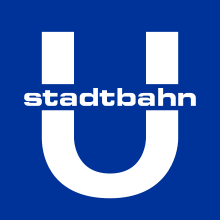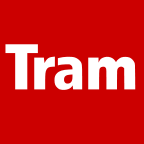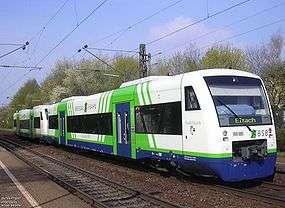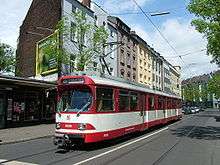Trams in Frankfurt am Main
|
Frankfurt am Main type R tram no. 021 at Ernst-May-Platz, Bornheim, 2007. | ||||||||||||||||||||||||||||
| Operation | ||||||||||||||||||||||||||||
|---|---|---|---|---|---|---|---|---|---|---|---|---|---|---|---|---|---|---|---|---|---|---|---|---|---|---|---|---|
| Locale | Frankfurt am Main, Hesse, Germany | |||||||||||||||||||||||||||
| ||||||||||||||||||||||||||||
| ||||||||||||||||||||||||||||
| ||||||||||||||||||||||||||||
The Frankfurt am Main tramway network is a network of tramways forming a major part of the public transport system in Frankfurt am Main, a city in the federal state of Hesse, Germany.
As of 2012, there were 10 tram lines,[1] along with two special lines and one heritage tourist tramline.[2][3] The network was also heavily integrated into the Frankfurt U-Bahn, with the systems sharing both street running and reserved track. In 2012, the network had 136 stations,[1] and a total route length of 67.25 kilometres (41.79 mi).[1] In the same year, the network carried 49.9 million passengers,[1] about 30% of total public transport ridership in Frankfurt.
History
The network is the oldest light rail system in the city, the first horse tram lines having started operations in 1872.[4] It includes one of the first electric tramways in the world, with the first electrified tram line starting in 1884.[4]
For many decades in the mid-20th century, it was the firm policy that Frankfurt's trams would eventually be phased out and replaced by buses and extensions of the U-Bahn.
With the start of construction of the Frankfurt U-Bahn closures began in 1963 on the tram. Underground and S-Bahn should replace the trams in the medium completely. The first metro line was opened in 1968, the second in 1974, the central S-Bahn tunnel 1978. Any progress in the rail network led to the closure of tram lines in order to avoid inefficient parallel traffic. With the opening of the third metro line in 1986, the "rail-free city" should be created: The tram should - to a predominant part replacement - completely disappear from the city center, the previous track surfaces for "appreciation" of the streets and places are used. This led to increasing criticism of this concept, culminating in public protests. Within a year, nearly 60,000 people signed for the preservation of the tram lines. Newspapers, radio and television devoted to the conflict. Even personalities like Professor Bernhard Grzimek and the subsequent DGB regional chairman Dieter Hooge expressed public criticism of the concept. As a result of citizen protests, the Regierungspräsidium Darmstadt rejected on 27 May 1986, the decommissioning of the old town stretch from. The Frankfurt Mayor Wolfram Brück criticized this decision and threatened with the withdrawal of Frankfurt from the Frankfurter Verkehrsverbund (FVV). Two days before the scheduled opening of the new subway route shifted bridge the opening of the underground indefinitely and banned all opening ceremonies. Only a few weeks later signaled the CDU's willingness to get the old town route bus No. 11. In turn, the provincial government Hartmut Wierscher renounced the maintenance of three additional lines. The preservation of the old town route finally ushered in a turning point in urban transport policy.
When the S-Bahn was opened from Frankfurt to Offenbach in 1995, this should mean the closure of the Offenbacher road segment, which, however, by citizen protests from Oberrad and transport initiatives (including Pro Bahn and the civic association "DALLES"), the attempted with special tours, to make the population aware of the tradition of the compound, could be prevented. In the follow-up period the tram by Offenbach always more than was "unwanted" viewed. To monitor the speed limit of 7 km/h in the pedestrian area of Offenbach Marktplatz, a speed measuring system was set up specifically for the tram by Offenbach. It was finally closed on 1 June 1996 to Offenbach Marktplatz.
But since the beginning of the 1990s, the direction of Frankfurt's urban traffic policy has changed and its tramways have been renovated and expanded, with a new route, Line 18, opening in 2011.[5] Although the various lines were founded by a number of private and public operators, all trams are now operated by Verkehrsgesellschaft Frankfurt (VGF, English: Frankfurt Transport Company), and the system is part of the Rhein-Main-Verkehrsverbund (RMV, English: Rhine-Main transport network).
Future
The future for the trams in Frankfurt are under discussion. These include:
- An extension of line 11 from "Zuckschwerdtstraße" to Höchst Station
- A new line from central station through "Gutleutstraße" to "Briefzentrum" replacing bus route 37
- A relocation of the former "Waldbahn" line (today's line 12) in Goldstein from the southern outskirts into "Straßburger Straße"
- An extension of line 12 to the Höchst Industrial Park
- A relocation of the old town route from the eastern part of "Battonnstraße" into "Allerheiligenstraße"
- A modernization of line 16 throughout Bockenheim and Ginnheim
- A third route crossing the river Main via "Alte Brücke" from Konstablerwache to Sachsenhausen
In 2005, the city's council was asked to examine whether a tram route to Uni Campus Westend could be build on Mainzer Landstrasse, Taunusanlage, Reuterweg and Bremer Platz, but this was denied in October 2006, because bus route 36 already serves this area in a sufficient way. And furthermore that on "Reuterweg" and "Mainzer Landstraße" two lanes in each directions are needed to cover the high amount of individual traffic and could not be dedicated as a tram line.
The establishment of a tram line to Bad Vilbel is no longer considered by the city council because the tram cars can not operate on slpoes larger than 10%, which "Frankfurter Straße" - part of the planned route - includes. In addition, researches resulted in the fact that a tram on this line would not be significantly faster than the current bus service.
Current network
As of 2014 there were eleven tram lines,[1] among them eight main lines, two rush hour reinforcement lines and one special line in Frankfurt:
| Line | Route |
|---|---|
| 11 | |
| 12 | |
| 14 | |
| 15 | |
| 16 | |
| 17 | |
| 18 | |
| 19 | |
| 20 | |
| 21 | |
| EE | |
Low-floor trams are being used since April 2007 on all regular lines. The Flexity Classic from Bombardier is the latest addition to the fleet.
The Ebbelwei express is a special line running on a loop from "Zoo" to "Messe/Schleife" via Altstadt and Sachsenhausen. The Ebbelwei-Express is a sightseeing line which runs only on weekends. Historic "K-type" trams are in operation on this route. Lieschen was a special line which ran from "Riedhof" to "Oberforsthaus" occasionally, only during a public festival called "Wäldchestag". Wäldchestag is only once a year during Pentecost, so the Frankfurt transit company VGF dismissed this line and its tracks in 2013.
The Stadtbahn line U5 is partly street running and uses the tracks of a former tram line. Originally the street running part on "Eckenheimer Landstraße" should be replaced by a subway, but due to a lack of funding as well as protests from the residents in this area who feard years of construction, those plans were canceled. Therefore instead the VGF used former "P-type" trams on this line that could serve both, subway and tram lines. Since April 2016 the stations in the street running part on "Eckenheimer Landstraße" are being conversed in to high-level platforms to fit the new "U5-25/U5-50-type" subway cars.
Ebbelwei-Expreß

This special line was started in 1977 on the occasion of the forthcoming decommission of the last two-truck trams and should have actually operated only for a short time. Owing to its enormous success, it remains in service to the present day.[2][3]
Fleet
- "K-type": 1949 - 1977 (several cars; in use as "Ebbelwei-Express" and departmental vehicles)
- "L-type": 1955 - 1983 (two motor cars and two trailer cars remaining; one of each as historic streetcar)
- "M-type": 1957 - 1998 (one motor car and two trailers remaining as historic streetcar)
- "N-type": 1963 - 2004 (one remaining as historic streetcar)
- "O-type": 1969 - 2005 (two remaining; one of them as historic streetcar)
- "P-type": 1972–present (partly decommissioned, still runs as "Ptb-type" on Line U5, 3 cars will remain as historic streetcar)
- "R-type": 1993 – present
- "S-type": 2003 – present
Frankfurt Transport Museum
The Frankfurt Transport Museum in Schwanheim shows the eventful history of Frankfurt's public transit. At least one of each type of streetcar (except types "E" and "G" and the ones that are still in operation) is preserved. In addition to that there is a small bus exhibition, showing two historic diesel-busses and one trolley-bus from Offenbach.
The "Historische Straßenbahn Frankfurt e.V." (Historic tramway organization) runs the museum on behalf of the Transport Company "VGF" and organizes shuttle services with old streetcars on special occasions.
See also
References
Notes
- 1 2 3 4 5 6 7 8 9 10 11 12 "ZAHLENSPIEGEL 2012" [STATISTICS 2012] (PDF) (in German). vgF. December 31, 2012. Retrieved 2013-09-29.
- 1 2 "City tour with the Ebbelwei-Express". vgF. Retrieved 2013-09-30.
- 1 2 "VGF Ebbelwei-Expreß". vgF. Retrieved 2013-09-30.
- 1 2 "History - The history of local public passenger transport in Frankfurt". vgF. Retrieved 2013-09-29.
- ↑ "New underground and tram lines". Retrieved 2012-02-07.
Bibliography
- Höltge, Dieter; Köhler, Günter H. (1992). Straßen- und Stadtbahnen in Deutschland [Tramways and Stadtbahnen in Germany] (in German). Band 1: Hessen [Volume 1: Hesse] (2nd., enlarged ed.). Freiburg i. B., Germany: EK-Verlag. ISBN 3882553359.
External links
| Wikimedia Commons has media related to Trams in Frankfurt am Main. |
- Verkehrsgesellschaft (vgF) Frankfurt - official site (German)
- Trampage Frankfurt (German)
- Frankfurt am Main database / photo gallery and Frankfurt am Main tram list at Urban Electric Transit – in various languages, including English.
- Frankfurt am Main database / photo gallery at Phototrans – in various languages, including English.
Coordinates: 50°06′28″N 08°39′53″E / 50.10778°N 8.66472°E
.png)



